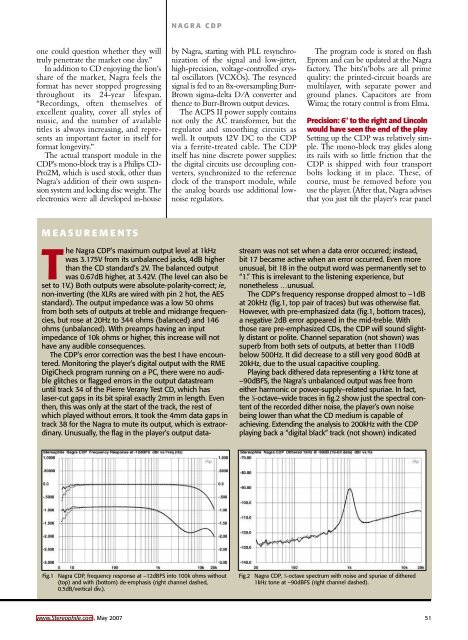home entertainment 2007
home entertainment 2007
home entertainment 2007
Create successful ePaper yourself
Turn your PDF publications into a flip-book with our unique Google optimized e-Paper software.
one could question whether they will<br />
truly penetrate the market one day.”<br />
In addition to CD enjoying the lion’s<br />
share of the market, Nagra feels the<br />
format has never stopped progressing<br />
throughout its 24-year lifespan.<br />
“Recordings, often themselves of<br />
excellent quality, cover all styles of<br />
music, and the number of available<br />
titles is always increasing, and represents<br />
an important factor in itself for<br />
format longevity.”<br />
The actual transport module in the<br />
CDP’s mono-block tray is a Philips CD-<br />
Pro2M, which is used stock, other than<br />
Nagra’s addition of their own suspension<br />
system and locking disc weight. The<br />
electronics were all developed in-house<br />
MEASUREMENTS<br />
NAGRA CDP<br />
The Nagra CDP’s maximum output level at 1kHz<br />
was 3.175V from its unbalanced jacks, 4dB higher<br />
than the CD standard’s 2V. The balanced output<br />
was 0.67dB higher, at 3.42V. (The level can also be<br />
set to 1V.) Both outputs were absolute-polarity-correct; ie,<br />
non-inverting (the XLRs are wired with pin 2 hot, the AES<br />
standard). The output impedance was a low 50 ohms<br />
from both sets of outputs at treble and midrange frequencies,<br />
but rose at 20Hz to 344 ohms (balanced) and 146<br />
ohms (unbalanced). With preamps having an input<br />
impedance of 10k ohms or higher, this increase will not<br />
have any audible consequences.<br />
The CDP’s error correction was the best I have encountered.<br />
Monitoring the player’s digital output with the RME<br />
DigiCheck program running on a PC, there were no audible<br />
glitches or flagged errors in the output datastream<br />
until track 34 of the Pierre Verany Test CD, which has<br />
laser-cut gaps in its bit spiral exactly 2mm in length. Even<br />
then, this was only at the start of the track, the rest of<br />
which played without errors. It took the 4mm data gaps in<br />
track 38 for the Nagra to mute its output, which is extraordinary.<br />
Unusually, the flag in the player’s output data-<br />
Fig.1 Nagra CDP, frequency response at –12dBFS into 100k ohms without<br />
(top) and with (bottom) de-emphasis (right channel dashed,<br />
0.5dB/vertical div.).<br />
by Nagra, starting with PLL resynchronization<br />
of the signal and low-jitter,<br />
high-precision, voltage-controlled crystal<br />
oscillators (VCXOs). The resynced<br />
signal is fed to an 8x-oversampling Burr-<br />
Brown sigma-delta D/A converter and<br />
thence to Burr-Brown output devices.<br />
The ACPS II power supply contains<br />
not only the AC transformer, but the<br />
regulator and smoothing circuits as<br />
well. It outputs 12V DC to the CDP<br />
via a ferrite-treated cable. The CDP<br />
itself has nine discrete power supplies:<br />
the digital circuits use decoupling converters,<br />
synchronized to the reference<br />
clock of the transport module, while<br />
the analog boards use additional lownoise<br />
regulators.<br />
The program code is stored on flash<br />
Eprom and can be updated at the Nagra<br />
factory. The bits’n’bobs are all prime<br />
quality: the printed-circuit boards are<br />
multilayer, with separate power and<br />
ground planes. Capacitors are from<br />
Wima; the rotary control is from Elma.<br />
Precision: 6" to the right and Lincoln<br />
would have seen the end of the play<br />
Setting up the CDP was relatively simple.<br />
The mono-block tray glides along<br />
its rails with so little friction that the<br />
CDP is shipped with four transport<br />
bolts locking it in place. These, of<br />
course, must be removed before you<br />
use the player. (After that, Nagra advises<br />
that you just tilt the player’s rear panel<br />
stream was not set when a data error occurred; instead,<br />
bit 17 became active when an error occurred. Even more<br />
unusual, bit 18 in the output word was permanently set to<br />
“1.” This is irrelevant to the listening experience, but<br />
nonetheless …unusual.<br />
The CDP’s frequency response dropped almost to –1dB<br />
at 20kHz (fig.1, top pair of traces) but was otherwise flat.<br />
However, with pre-emphasized data (fig.1, bottom traces),<br />
a negative 2dB error appeared in the mid-treble. With<br />
those rare pre-emphasized CDs, the CDP will sound slightly<br />
distant or polite. Channel separation (not shown) was<br />
superb from both sets of outputs, at better than 110dB<br />
below 500Hz. It did decrease to a still very good 80dB at<br />
20kHz, due to the usual capacitive coupling.<br />
Playing back dithered data representing a 1kHz tone at<br />
–90dBFS, the Nagra’s unbalanced output was free from<br />
either harmonic or power-supply–related spuriae. In fact,<br />
the 1 ⁄3-octave–wide traces in fig.2 show just the spectral content<br />
of the recorded dither noise, the player’s own noise<br />
being lower than what the CD medium is capable of<br />
achieving. Extending the analysis to 200kHz with the CDP<br />
playing back a “digital black” track (not shown) indicated<br />
Fig.2 Nagra CDP, 1 ⁄3-octave spectrum with noise and spuriae of dithered<br />
1kHz tone at –90dBFS (right channel dashed).<br />
www.Stereophile.com, May <strong>2007</strong> 51

















